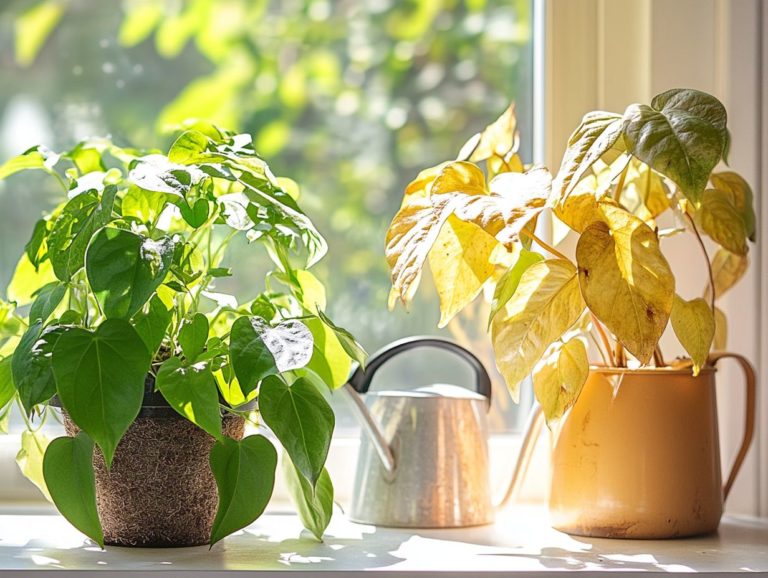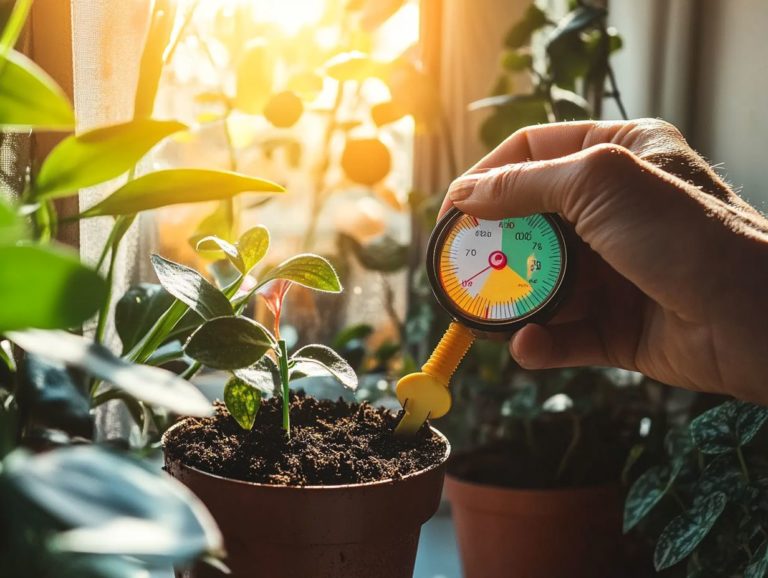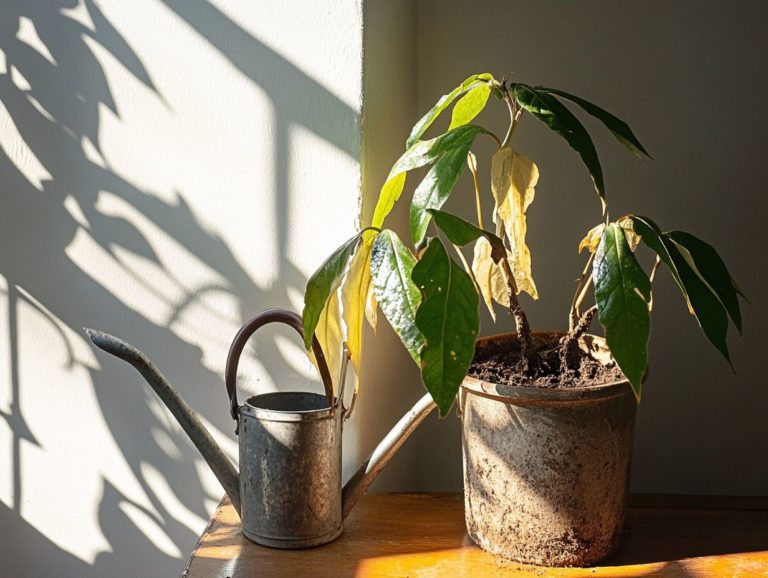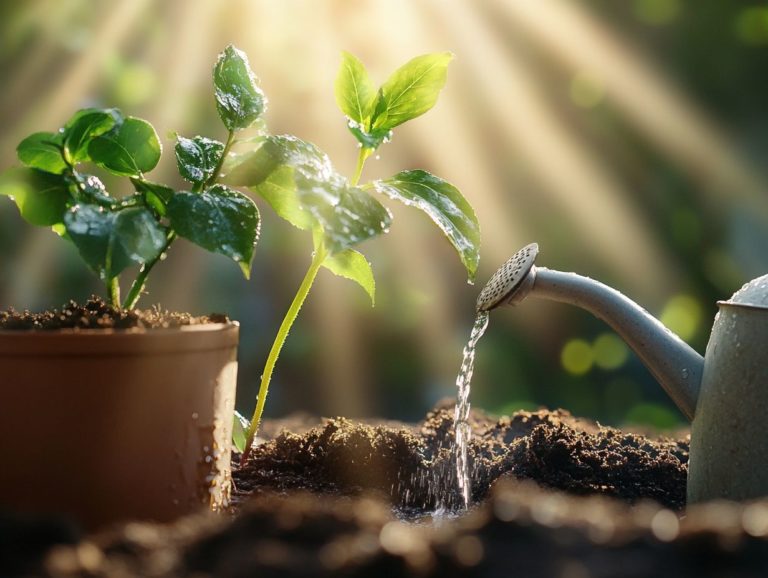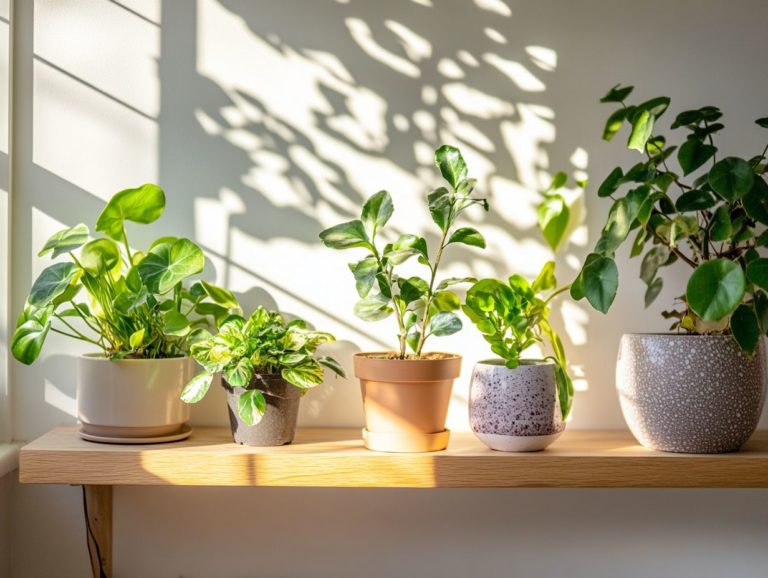How to Adjust Watering During Plant Growth Stages
Watering is essential for nurturing healthy plants. However, it often slips under the radar when considering efficient techniques.
Finding the perfect balance between underwatering and overwatering can make all the difference in your plant s growth journey. This guide will help you adjust your watering routine based on different growth stages seedling, vegetative, and flowering while taking into account the specific watering frequency for various plant types.
Consider key factors such as soil type, climate, and plant species, as these will shape your watering strategy. You can use effective tools and techniques to streamline your watering process, including mulch application for better moisture retention.
Dive in! Your plants can not only survive but truly thrive, whether you’re growing a vegetable garden or nurturing ornamental shrubs!
Contents
- Key Takeaways:
- The Importance of Proper Watering for Plant Growth
- Adjusting Watering for Different Growth Stages
- Factors to Consider When Watering Plants
- Tools and Techniques for Watering Plants
- Frequently Asked Questions
- What are the key growth stages of a plant? Let s explore!
- Why should you adjust your watering as plants grow?
- How do I adjust watering during the seed germination stage?
- What should I do during the vegetative growth stage?
- How can I adjust watering during the flowering stage?
- Do I need to adjust watering during the fruiting stage?
Key Takeaways:

- Proper watering is crucial for healthy plant growth. Underwatering and overwatering can have negative effects on established plants and new shrubs.
- The watering needs of plants, from shallow-rooted vegetables to deep-rooted plants, change during different growth stages. Adjusting watering schedules is important for optimal growth.
- When watering plants, consider factors such as soil type, climate, and the specific species and size of your plants. Using the right tools and techniques can also ensure proper watering.
The Importance of Proper Watering for Plant Growth
Proper watering is crucial for the growth and vitality of all plants, from newly planted shrubs to established flora such as Mondo Grass and deep-rooted trees. By understanding efficient watering methods, watering frequency, and specific schedules, you can significantly enhance tree health, maintain optimal soil moisture levels, and promote robust root development across your garden.
A thoughtfully crafted watering strategy alleviates the stress plants feel when moved. It also ensures precise water delivery to established plants. This way, both shallow-rooted vegetables like zucchini and deep-rooted plants can thrive beautifully in various gardening environments.
Effects of Underwatering and Overwatering
Both underwatering and overwatering can have a detrimental effect on your plants health, causing issues like stunted growth and subpar moisture levels, ultimately affecting your garden s overall nutrient uptake.
When you look at established plants, you might notice signs such as wilting or yellowing leaves clear indicators that they’re feeling stressed from improper watering practices, which can be exacerbated by a high evaporation rate. For new shrubs, maintaining that delicate balance of moisture becomes even more crucial. They need consistent hydration to develop strong root systems and adapt to changing climate conditions.
Insufficient water can lead to roots staying shallow, especially in shallow-rooted vegetables. Too much water can drown them, ultimately resulting in rot. By gaining a thorough understanding of each plant’s specific moisture requirements, including soil type and drainage capacity, and regularly monitoring soil conditions, you can ensure optimal health and vitality. This proactive approach will promote flourishing growth throughout the seasons.
Adjusting Watering for Different Growth Stages
Understanding how to tailor your watering techniques for various growth stages is essential for cultivating thriving plants. Whether you’re nurturing new seedlings or caring for established plants like tomatoes and radishes, customized watering schedules can profoundly impact plant vitality.
Each growth stage demands unique strategies to maintain optimal moisture and promote efficient root development, which is vital for maximizing nutrient availability.
Seedling Stage
Proper watering is crucial during the seedling stage. Newly planted seeds experience stress when moved, which can affect their growth.
Understanding the watering needs of your seedlings is essential for their healthy development. Maintain consistent soil moisture to prevent drying out or waterlogging.
Check water levels regularly. This attention in the early stages enhances your plants’ resilience and vigor as they mature.
Vegetative Stage

During the vegetative stage, prioritize consistent watering to encourage strong root development. A well-established root system effectively absorbs nutrients and water from the soil.
Monitor soil moisture levels regularly. Ensure that the soil neither becomes too dry nor overly saturated, as both can hinder growth.
Deep watering encourages roots to grow downward. This practice promotes healthier plants that can withstand environmental stressors.
Flowering Stage
The flowering stage requires careful attention to watering timing and methods. This is essential for enhancing tree health and maximizing flower production.
Understanding hydration needs during this critical phase can significantly influence the quality of your blooms. Adequate moisture at the right intervals boosts overall plant vitality.
A well-timed watering schedule aligns with your trees’ physiological responses and enhances nutrient uptake. Techniques like deep watering and effective mulch application develop a healthier root system.
Adopting a strategic approach to watering is vital for nurturing thriving trees and maximizing their flowering potential.
Factors to Consider When Watering Plants
When establishing an effective watering routine, consider several key factors: soil type, drainage capacity, climate conditions, and the specific species and size of your plants.
Each of these elements plays a vital role in achieving optimal watering conditions that promote healthy growth. Understanding how each factor interacts with your watering methods can enhance water retention and minimize stress on your plants.
Soil Type and Drainage
The type of soil and its drainage capabilities are crucial. Sandy, clay, and loamy soils all affect how much water is retained and how well your plants absorb moisture.
Each soil type exhibits unique characteristics that significantly influence water-holding capacity and overall soil health. For instance, sandy soil drains quickly, often creating challenges in retaining moisture, which can lead to drought stress for your plants, particularly during hot spells.
Clay soils hold onto water but can also cause waterlogging, hindering root aeration essential for healthy growth. Loamy soils strike the perfect balance, providing an ideal blend of drainage and water retention. Understanding these differences can transform your garden!
Climate and Weather
Climate and weather conditions play a crucial role in how quickly water evaporates. This shapes how often and how much you should water your plants, especially during hot and dry spells.
Fluctuations in weather can lead to significant adjustments in your watering schedule. During extreme heat or drought, plants may require more frequent hydration. Stay alert to the weather! Your plants depend on you for the right hydration.
On sunny days, the risk of rapid evaporation rises. Early morning or late evening watering is a smart choice, along with mulch to retain soil moisture. Consider adding mulch to help retain moisture, and use drip irrigation systems to water plants directly at their roots.
By monitoring local weather patterns, you can make informed decisions about watering frequency, promoting healthier gardens and efficient water use throughout the growing season.
Plant Species and Size

Different plant species and their varying sizes, such as Fescue, Bermuda, and St. Augustine, demand customized watering approaches. Established plants and newly planted shrubs have distinct moisture requirements.
For example, succulents like cacti need considerably less water compared to larger leafy plants such as ferns, which flourish in moisture-rich environments. An overwatered succulent is prone to root rot, while an underwatered fern may wilt and struggle to thrive, impacting overall garden aesthetics.
Young saplings require frequent, gentle watering to help establish their roots. In contrast, mature trees thrive on less frequent but deeper watering sessions that promote strong root development. Tailoring watering frequency and methods to the specific needs of each species ensures their survival and fosters healthy growth.
Tools and Techniques for Watering Plants
You have a wealth of tools and techniques for effective watering, from watering cans and hoses to drip irrigation systems and soaker hoses. Each can be customized to suit your garden s unique needs.
Consider incorporating watering timers into your routine; they optimize your watering schedule, ensuring your plants receive the right amount of moisture while eliminating the risks of over- or underwatering.
By understanding the advantages of each tool, you can significantly enhance water delivery and cultivate efficient watering practices that benefit your garden. Start using these tips to improve your gardening immediately!
Watering Cans and Hoses
Watering cans and hoses are essential tools for manual watering. They give you direct control over how much water each plant receives.
These tools come in various shapes and sizes, offering distinct advantages for specific watering needs. A classic watering can, often made from metal or plastic, is ideal for small gardens or potted plants. It delivers a gentle flow that minimizes soil disturbance.
Hoses are designed for larger areas, making it easy to water expansive beds. With various attachments like soaker hoses and spray nozzles, you can direct water right to the roots or create a fine mist to protect delicate seedlings.
By understanding the benefits of each option, you can maintain optimal soil moisture levels and ensure your plants thrive beautifully.
Drip Irrigation Systems
Drip irrigation systems provide an effective method to water your plants, delivering water straight to their roots. This technique maximizes efficiency and minimizes evaporation, making sure that each drop counts.
By directing moisture exactly where it’s needed in the root zone, these systems improve soil water retention and reduce runoff. This targeted approach hydrates a variety of crops while also supplying essential nutrients alongside the water.
You can fine-tune drip irrigation strategies to meet the specific needs of different plants. This makes it a sustainable choice that conserves water and significantly reduces labor costs compared to traditional watering methods. You’ll enjoy both economic and ecological advantages as a gardener or farmer.
Watering Timers
Watering timers are crucial for automating irrigation systems. They ensure your plants receive consistent moisture according to a well-planned schedule, helping to prevent over- or underwatering.
By integrating these devices into your setups be it drip systems or sprinkler systems you achieve enhanced efficiency and precision in water usage. The benefits of using watering timers extend beyond convenience; they help maintain an optimal watering frequency tailored to the unique needs of different plants. This promotes healthier growth and more robust yields.
You can easily program these timers for seasonal changes, ensuring your garden thrives year-round! This level of control conserves water and minimizes labor in garden maintenance, making watering timers an invaluable asset for both amateur gardeners and seasoned horticulturists.
Frequently Asked Questions
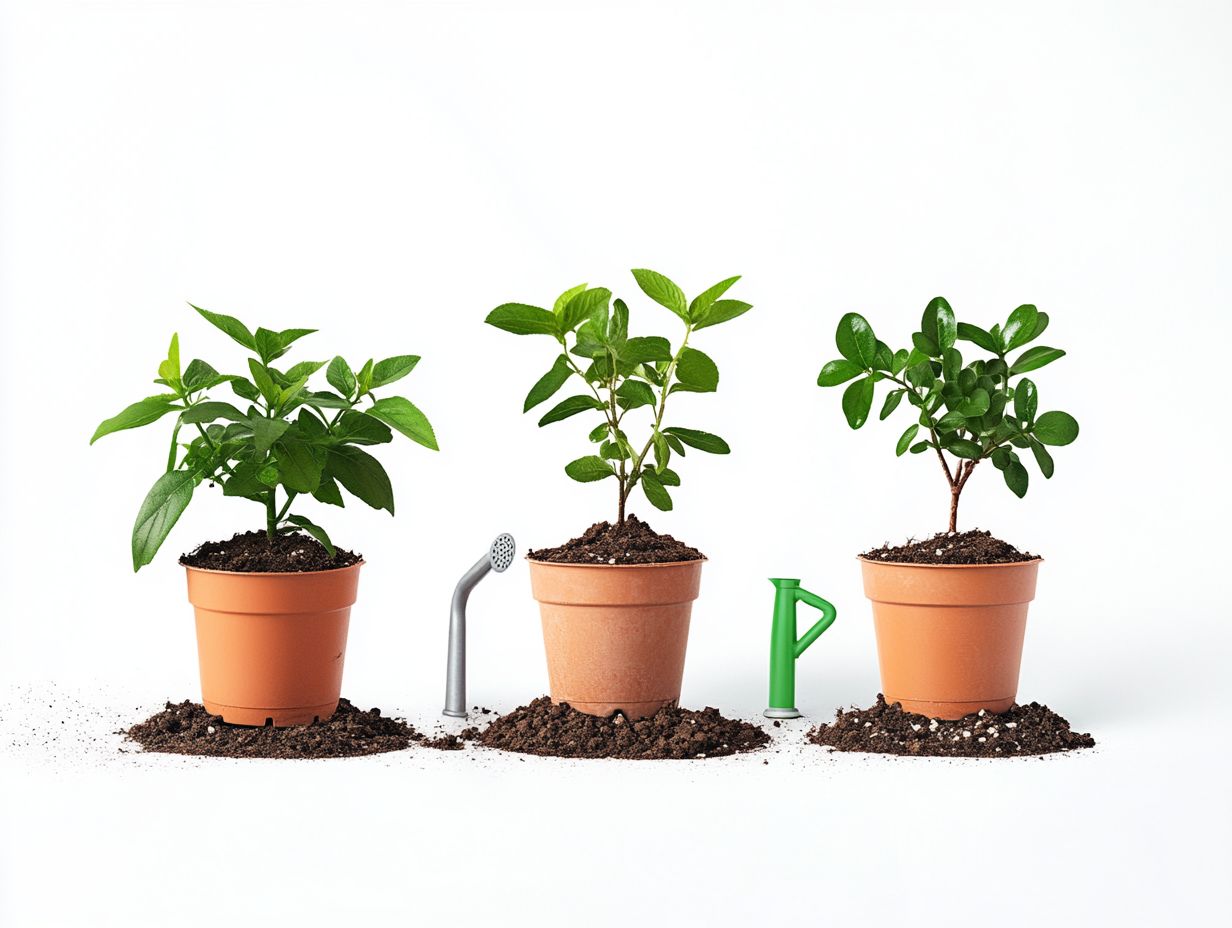
What are the key growth stages of a plant? Let s explore!
The growth stages of a plant include seed germination, vegetative growth, flowering, and fruiting.
Why should you adjust your watering as plants grow?
The watering needs of a plant change during different growth stages. Adjusting watering ensures healthy growth and development.
How do I adjust watering during the seed germination stage?
During seed germination, keep the soil moist but not soaked. Water lightly every day or every other day to avoid waterlogging.
What should I do during the vegetative growth stage?
During this stage, plants need more water to support leaf and stem growth. Water deeply once or twice a week, allowing the soil to dry out slightly between waterings.
How can I adjust watering during the flowering stage?
During the flowering stage, plants need consistent moisture to produce healthy blooms. Water deeply 2-3 times a week, ensuring the soil remains moist but not waterlogged.
Do I need to adjust watering during the fruiting stage?
Yes, during the fruiting stage, plants require even moisture to support fruit development. Water deeply 2-3 times a week to keep the soil consistently moist.
Ready to implement these watering techniques in your garden? Start today for healthier plants and a thriving garden!

